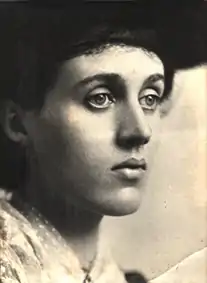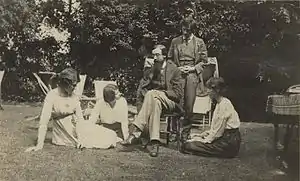Vanessa Bell
Vanessa Bell (née Stephen; 30 May 1879 – 7 April 1961) was an English painter and interior designer, a member of the Bloomsbury Group and the sister of Virginia Woolf.
Vanessa Bell | |
|---|---|
 Portrait of Vanessa Bell, 1916 by Roger Fry (1866–1934) | |
| Born | Vanessa Stephen 30 May 1879 London, England |
| Died | 7 April 1961 (aged 81) Charleston Farmhouse, Sussex, England |
| Alma mater | King's College London |
| Occupation | Painter, interior designer |
| Spouse(s) | |
| Children | |
| Parent(s) | |
| Relatives |
|
Early life and education

Vanessa Stephen was the elder daughter of Sir Leslie Stephen and Julia Prinsep Duckworth.[1] The family included her sister Virginia, brothers Thoby (1880–1906) and Adrian (1883–1948), and half-brothers George and Gerald Duckworth; they lived at 22 Hyde Park Gate, Westminster, London. She was educated at home in languages, mathematics and history, and took drawing lessons from Ebenezer Cook before she attended Sir Arthur Cope's art school in 1896. She then studied painting at the Royal Academy in 1901.
Later in life, she alleged that during her childhood she had been sexually abused by her half-brothers, George and Gerald Duckworth.[2]
Private life

After the deaths of her mother in 1895 and her father in 1904, Vanessa sold 22 Hyde Park Gate and moved to Bloomsbury with Virginia and brothers Thoby and Adrian,[3] where they met and began socialising with the artists, writers and intellectuals who would come to form the Bloomsbury Group. The Bloomsbury Group's first Thursday evening meetings began at Bell's house in Gordon Square.[1] Attendees included: Lytton Strachey, Desmond MacCarthy and, later on, Maynard Keynes, Leonard Woolf, Roger Fry and Duncan Grant.
She married Clive Bell[3] in 1907 and they had two sons, Julian (who died in 1937 during the Spanish Civil War at the age of 29)[1] and Quentin. The couple had an open marriage,[3] both taking lovers throughout their lives. Bell had affairs with art critic Roger Fry and with the painter Duncan Grant,[1] with whom she had a daughter, Angelica in 1918, whom Clive Bell raised as his own child.[4]

Vanessa, Clive, Duncan Grant and Duncan's lover David Garnett moved to the Sussex countryside shortly before the outbreak of the First World War, and settled at Charleston Farmhouse near Firle, East Sussex, where she and Grant painted and worked on commissions for the Omega Workshops established by Roger Fry. Her first solo exhibition was at the Omega Workshops in 1916.[5] On April 7, 1961, Bell died from a brief illness at Charleston, Firle and was buried in the Firle Parish Churchyard. When Duncan Grant died in 1978, he was buried next to her.
Art
%253B_Duncan_Grant%253B_Eric_Siepmann%252C_1922.jpg.webp)
In 1906, when Bell started to think of herself as an artist, she formed the Friday Club to create a place in London that was more favourable to painting.[6] Vanessa was encouraged by the Post-Impressionist exhibitions organised by Roger Fry, and she copied their bright colours and bold forms in her artworks. In 1914, she turned to Abstraction.[7]
Bell rejected the examples of Victorian narrative painting and rejected a discourse on the ideal and aberrant qualities of femininity. She also designed book jackets for all of her sister Virginia's books that were published by Virginia and Leonard Woolf's publishing company, the Hogarth Press.[8]
Bell is one of the most celebrated painters of the Bloomsbury group. She exhibited in London and Paris during her lifetime, and has been praised for innovative works and for her contributions to design.[9]
Bell's paintings include Studland Beach (1912),[10] The Tub (1918), Interior with Two Women (1932), and portraits of her sister Virginia Woolf (three in 1912), Aldous Huxley (1929–1930) and David Garnett (1916). Bell also worked with Duncan Grant to create murals for Berwick Church in Sussex (1940–42).[11]
In 1932, Bell and Grant were commissioned to produce a dinner service for Kenneth Clark.[12] With oversight from Kenneth's wife Jane Clark, they produced the Famous Women Dinner Service: 50 plates painted with portraits of notable women throughout history. The collection eventually passed on to a private collector, and passed out of public view until 2017. The full collection was exhibited in London in early 2018.[13]
Exhibitions
In 1916, Bell's first solo exhibition was held in the Omega Workshop in London, a prominent place for exhibitions which supported young artists and introduced design work to the public. Bell became the director of the Omega Workshop around 1912.
Iceland Poppies (1908) was exhibited at the New English Art Club in the summer of 1909. It was praised by Walter Sickert and marks Bell's artistic maturity.[6]
Designs for a Screen: Figures by a Lake (1912), gouache on board, was influenced by Nabis paintings by Édouard Vuillard and Maurice Denis and might have been a part of Bell's exhibit Design for Screen, which was shown at the Friday Club Exhibition in February 1912.[14]
Design for Overmantel Mural (1913), oil on paper, depicts herself and Molly MacCarthy naked in Bell's studio at 46 Gordon Square.
Street Corner Conversation (also created in 1913) features four individuals in conversation amidst massive geometrical forms.
Summer Camp (1913), oil on board, illustrates a summer camp organized at Brandon on the Norfolk-Suffolk border near Thetford.
By the Estuary (1915), oil on canvas, is a modestly scaled landscape showing her fondness for clarity of design in which segments of contrasting color harmonize.
Nude with Poppies (1916), oil on canvas, is a preliminary design for a headboard which Bell painted for Mary Hutchinson.
Media portrayal
Bell was portrayed by Janet McTeer in the 1995 Dora Carrington biopic Carrington, and by Miranda Richardson in the 2002 film The Hours.
Bell is the subject of Susan Sellers' 2010 novel Vanessa and Virginia and of Priya Parmar's 2014 novel Vanessa and Her Sister. In 2015 she was portrayed by Phoebe Fox and Eve Best in the BBC mini-series Life in Squares.[15]
Bell was portrayed by Emerald Fennell in the 2018 film Vita and Virginia.
References
- Jones, Marnie (Winter 1985). "Review: Her Own Story". The American Scholar. 54 (1): 130. JSTOR 41211148.
- Dunn, Jane. (1990) A Very Close Conspiracy: Vanessa Bell and Virginia Woolf. London: Jonathan Cape, pp. 20-21. ISBN 9780224022347
- Jones, Marnie (Winter 1985). "Review: Her Own Story". The American Scholar. 54 (1): 131. JSTOR 41211148.
- Archive Journeys: Bloomsbury
- Shone, Richard. (1999) The Art of Bloomsbury Roger Fry, Vanessa Bell, and Duncan Grant. Princeton: Princeton University Press, pp. 137-138. ISBN 0691049939.
- Frances Spalding. "Bell, Vanessa". Grove Art Online. Oxford Art Online. Oxford University Press. Retrieved 21 February 2015.
- Chilvers, Ian. "Bell, Vanessa". The Oxford Companion to Western Art. Ed. Hugh Brigstocke. Oxford Art Online. Oxford University Press. Retrieved 21 February 2015.
- Catlin, Roger. "A sister's bookish art for her sister, Virginia's, publishing company, the Hogarth Press". Washington Post.
- Vanessa Bell and Dora Carrington: Bloomsbury Painters. Gillian Elinor. Woman's Art Journal. Vol. 5, No. 1 (Spring-Summer 1984), pp. 28-34. Woman's Art Inc. Stable URL: https://www.jstor.org/stable/1357882.
- Tickner 1999.
- "Introduction to the Berwick Murals". Berwick Church.
- Leaper, Hana (30 November 2017). "The Famous Women Dinner Service: A Critical Introduction and Catalogue". British Art Studies (7). doi:10.17658/issn.2058-5462/issue-07/hleaper. ISSN 2058-5462. Retrieved 1 December 2017.
- "Decades Before Judy Chicago's 'The Dinner Party,' Virginia Woolf's Sister Made a Set of Dinner Plates Celebrating 50 Historic Women | artnet News". artnet News. 2018-03-29. Retrieved 2018-11-25.
- Shone, Richard. The Art of Bloomsbury. Princeton: Princeton University Press. 1999.
- "BBC2: Life in Squares: Credits – Episode 1". BBC Online. Retrieved 10 August 2015.
Bibliography
- Spalding, Frances (2016) [1983]. Vanessa Bell: Portrait of the Bloomsbury Artist. I.B.Tauris. ISBN 978-1-78453-241-3.
- Tickner, Lisa (Winter 1999). "Vanessa Bell: Studland Beach, Domesticity, and "Significant Form"". Representations. 65 (Special Issue: New Perspectives in British Studies): 63–92. doi:10.1525/rep.1999.65.1.01p0033o. JSTOR 2902962.
- "Vanessa (Stephen) Bell (1879 - 1961)". WikiTree. 2018. Retrieved 2 January 2018.
- Sketches in Pen and Ink, Vanessa Bell
- A Passionate Apprentice: the early journals, Virginia Woolf
- A Moment's Liberty, Virginia Woolf
- A Very Close Conspiracy: Vanessa Bell and Virginia Woolf, Jane Dunn
- Duncan Grant, Frances Spalding
- Deceived with Kindness: a Bloomsbury Childhood, Angelica Garnett
- Elders and Betters, Quentin Bell
- Vanessa and Virginia, Susan Sellers (fictional biography)
- Charleston, Quentin Bell and Virginia Nicholson
- Virginia Woolf, Hermione Lee
- Vanessa and Her Sister, Priya Parmar (novel)
External links
| Wikimedia Commons has media related to Vanessa Bell. |
- 142 paintings by or after Vanessa Bell at the Art UK site
- Official site of the Charleston Farmhouse in Sussex
- A presentation by the Tate Gallery, including biographies, timeline, pictures etc
- Links to Vanessa Bell's works online
- Wiki-Genealogy
- "Archival material relating to Vanessa Bell". UK National Archives.

- Works by or about Vanessa Bell in libraries (WorldCat catalog)